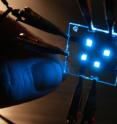Blue light specials
Lighting consumes one-fifth of the electricity generated in the United States. Solid-state lighting offers tremendous potential to improve the situation – once major research challenges are overcome. The most promising technology is the organic light-emitting diode, or OLED. These multi-layered devices produce light by running an electrical current through a specially engineered host material into which light-producing phosphorescent molecules are embedded or "doped." The white light envisioned for large-scale applications, such as rooms and buildings, consists of red, green and blue light.
"The weakest link in OLED research is the absence of an efficient, long-lasting blue light to accompany the red and green," said Pacific Northwest National Laboratory scientist Asanga Padmaperuma. Development of better host materials to manage the flow of electricity through the device could help solve that problem.
Padmaperuma and his collegues have designed, synthesized and tested new materials that improve the power efficiency of blue OLEDs by at least 25 percent.
On Sunday, March 22, PNNL scientists will discuss advancements in blue OLED research in two presentations and a poster session at the spring meeting of the American Chemical Society.
Source: DOE/Pacific Northwest National Laboratory
Other sources
- Efficiency Of Blue Organic Light-emitting Diode Boosted By 25%from Science DailySun, 22 Mar 2009, 21:28:15 UTC
- Blue light specials: New materials boost efficiency of blue OLEDs by 25 percentfrom PhysorgSun, 22 Mar 2009, 19:14:06 UTC
